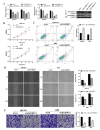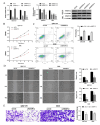ADAMDEC1 promotes the malignant progression of cholangiocarcinoma by regulating NF-κB signaling pathway
- PMID: 39755752
- PMCID: PMC11700112
- DOI: 10.1038/s41598-025-85241-6
ADAMDEC1 promotes the malignant progression of cholangiocarcinoma by regulating NF-κB signaling pathway
Abstract
Cholangiocarcinoma (CCA), a highly aggressive form of cancer, is known for its high mortality rate. A Disintegrin and Metalloprotease Domain-like Protein Decysin-1 (ADAMDEC1) can promote the development and metastasis in various tumors by degrading the extracellular matrix. However, its regulatory mechanism in CCA remains unclear. Public databases and clinical tissue samples were used to evaluate whether ADAMDEC1 expression was correlated with the prognosis of CCA. We investigated the expression of ADAMDEC1-related regulatory genes and proteins in CCA and assessed the biological behaviors of CCA cells in vitro through functional experiments. Meanwhile, the interacting proteins of ADAMDEC1 and its involvement in the nuclear factor-kappa B (NF-κB) signaling pathway were screened and verified through bioinformatics analysis. The tumorigenicity of CCA was also assessed in a xenograft nude mouse model. Our results showed that ADAMDEC1 was highly expressed in tumor tissues from CCA patients and was positively correlated with poor prognosis. Interference cell lines targeting ADAMDEC1 in CCA cells were successfully constructed. Knockdown of ADAMDEC1 or MMP12 both affected the biological behaviors of CCA cells, and ADAMDEC1 silencing inhibited tumorigenicity and tumor growth of CCA in vivo. Moreover, ADAMDEC1 interacted with MMP12, modulating its expression and promoting the activation of the NF-κB signaling pathway. Our study uncovered the expression patterns and functional roles of ADAMDEC1 in CCA cells and tissues, highlighting its connection to the NF-κB pathway and MMP12 in the development of CCA. Therefore, ADAMDEC1 may serve as a potential therapeutic target for CCA.
Keywords: ADAMDEC1; CCA; MMP12; NF-κB; Tumorigenesis.
© 2025. The Author(s).
Conflict of interest statement
Declarations. Competing interests: The authors declare no competing interests.
Figures





Similar articles
-
CD147 augmented monocarboxylate transporter-1/4 expression through modulation of the Akt-FoxO3-NF-κB pathway promotes cholangiocarcinoma migration and invasion.Cell Oncol (Dordr). 2020 Apr;43(2):211-222. doi: 10.1007/s13402-019-00479-3. Epub 2019 Nov 15. Cell Oncol (Dordr). 2020. PMID: 31729681
-
Oncogenic activity of retinoic acid receptor γ is exhibited through activation of the Akt/NF-κB and Wnt/β-catenin pathways in cholangiocarcinoma.Mol Cell Biol. 2013 Sep;33(17):3416-25. doi: 10.1128/MCB.00384-13. Epub 2013 Jun 24. Mol Cell Biol. 2013. PMID: 23798555 Free PMC article.
-
CARD9 promotes cholangiocarcinoma by regulating the IL-17A/Hedgehog and the THEM4/AKT/mTOR signaling pathways.Int Immunopharmacol. 2024 Dec 25;143(Pt 2):113399. doi: 10.1016/j.intimp.2024.113399. Epub 2024 Oct 16. Int Immunopharmacol. 2024. PMID: 39418733
-
Targeting the PI3K/AKT/mTOR pathway offer a promising therapeutic strategy for cholangiocarcinoma patients with high doublecortin-like kinase 1 expression.J Cancer Res Clin Oncol. 2024 Jul 9;150(7):342. doi: 10.1007/s00432-024-05875-3. J Cancer Res Clin Oncol. 2024. PMID: 38980538 Free PMC article.
-
Reprogramming of fatty acid metabolism: a hidden force regulating the occurrence and progression of cholangiocarcinoma.Cell Death Discov. 2025 Feb 21;11(1):72. doi: 10.1038/s41420-025-02351-w. Cell Death Discov. 2025. PMID: 39984452 Free PMC article. Review.
References
-
- Öztürk, N. B. & Jamil, L. H. An assessment of risk factors for recurrence and survival for patients undergoing liver resection for intrahepatic cholangiocarcinoma. Eur. J. Gastroenterol. Hepatol.36 (6), 766–774 (2024). - PubMed
-
- Qurashi, M., Vithayathil, M. & Khan, S. A. Epidemiology of cholangiocarcinoma. Eur. J. Surg. Oncol.9, 107064 (2023). - PubMed
Publication types
MeSH terms
Substances
Grants and funding
LinkOut - more resources
Full Text Sources
Medical
Miscellaneous

